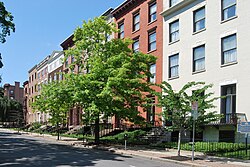Lafayette Park Historic District | |
 Elk Street row houses, 2011 | |
 | |
| Location | Albany, NY |
|---|---|
| Coordinates | 42°39′11″N 73°45′24″W / 42.65306°N 73.75667°W |
| Area | 36 acres (15 ha; 150,000 m2)[2] |
| NRHP reference No. | 78001837[1] |
| Added to NRHP | November 15, 1978 |
The Lafayette Park Historic District is located in central Albany, New York, United States. It includes the park and the combination of large government buildings and small rowhouses on the neighboring streets. In 1978 it was recognized as a historic district and listed on the National Register of Historic Places (NRHP).[1] Many of its contributing properties are themselves listed on the National Register. One of them, the New York State Capitol, is a National Historic Landmark as well. Other government buildings include City Hall, the building housing Albany County government, the state's highest court and the offices of its Education Department along with the offices of the City School District of Albany. The Episcopal Diocese of Albany's cathedral is at one corner of the district.
While the state capitol building has always been located on its present site, for most of the 19th century the neighborhood was best known for the townhouses on Elk Street, then one of the most desirable addresses in the city. Many politicians, including some of the state's governors and presidents Martin Van Buren[2] and Franklin D. Roosevelt,[3]: 70–74 lived there at different times. Henry James would recall the neighborhood from his childhood visits to his aunt as "vaguely portentous, like beasts of the forest not wholly exorcised."[2] Two significant technological accomplishments—the development of the first working electromagnet[4] and the construction of the first cantilevered arch bridge[2]: 6, 10–11 —also took place within it. Henry Hobson Richardson, Philip Hooker and Marcus T. Reynolds are among the architects with buildings in the district.
The park that gives the district its name was not actually built until the early 20th century, after larger government buildings had begun to dominate the area. In it and the other three parks are statues commemorating George Washington and Albany natives like Civil War general Phillip Sheridan and electromagnet discoverer Joseph Henry. John Quincy Adams Ward and J. Massey Rhind are among the sculptors represented. Although the district has been affected by modern trends—most of the Elk Street houses are now offices for various organizations that lobby the state government—it has remained mostly intact. It remains a vital part of Albany's public sphere, with the parks having hosted everything from benefit sales for soldiers' medical care during the Civil War to Occupy Albany's tent encampments and protests during the 2010s.
- ^ a b "National Register Information System". National Register of Historic Places. National Park Service. March 13, 2009.
- ^ a b c d Brook, C.E.; Spencer-Ralph, E. (April 1975). "National Register of Historic Places Inventory/Nomination: Lafayette Park Historic District". U.S. National Archives. Retrieved July 18, 2020.
- ^ Opalka, Anthony (1993). Diana Waite (ed.). Albany Architecture: A Guide to the City. Albany, NY: Mount Ida Press. ISBN 9780962536816. Retrieved July 19, 2002.
- ^ Hochfelder, David (1998–2007). "Joseph Henry: Inventor of the Telegraph?". Smithsonian Institution. Retrieved October 26, 2020.


